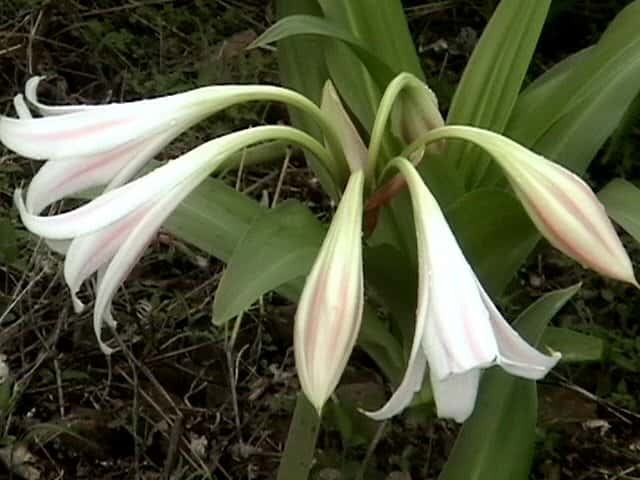Sudarshana

Botanical Name : Crinum latifolium
Family : Amaryllidaceae
Introduction :
Sudarsana is a bulbous plant with lance shaped leaves and beautiful bell shaped white flowers. The plant stays dormant for several months of the year, leaves and flowers appear before the monsoon.
Names in different Indian languages :
Kannada : Visha mungali
Malayalam : Jovannapolatali
Tamil : Vishamungil
Marathi : Gadambhikanda, Gandani-kanda, Golkamdo, Gul-sabu
Sanskrit : Cakrangi, Daddhyali, Sudarsana
Synonyms :
Chakrahwa,Durdarshana,Kandali,Meshaka
Morphology :
It is a small plant growing to a height of 2-3 ft.The leaves are big,growing to a length of 2-4 ft and 3-4 inch wide.The leaves emerge from the rhizome and resembles like emerging from the ground.The flowering stem are stout,reaching about 2 m in height.The flowers have white colour and pinkish tinge,emerge from the middle stalk and arrangeed in an umbel.The fruits are round,2-2.5 inch in diameter having 10-12 seeds inside.The plant is found all over India in the temperate climate especially Central India
Distribution and Habitat :
Cultivated all over India
Chemical Constituents :
Glucans, organic acids, saponin, aminoacids, alkaloids.
Glucans: glucan A and B.
Aminoacids: phenylalanine, L-leucin, DL-valin, L-arginin monohydrochloride.
Alkaloids: latisolin, latisodin, Ambellin, 11-0-acetylambellin, 11-0 acetyl 1, 2-ß epoxyambellin, crinafolin, crinafolidin, lycorin, epilycorin, epipancrassidin, 9-0-demethylhomolycorin, lycorin-1, 0-glucosid, pratorin (hippadin), pratorinin, pratorimin, pratosin, beladin, latindin, latifin
Properties :
Rasa : Madhura
Veerya : Ushna
Karma : Sotha,Raktavata,Kaphahara
Indications :
Jvara,shotha
Part Used :
Patra,Kanda
Dosage :
Swarasa: 5-10ml
Kanda churna : 1-2gms
Uses :
Folkloric significance of Crinums: Crinum species have a considerable medicinal reputation as potent folkloric remedies. Their use extended from the ancient times to nowadays especially in Africa, tropical Asia and South America. Several Crinums are traditionally used as emetics, laxatives, expectorants, tonics, antipyretics, diuretics, diaphoretics, anti-asthmatics, anti-malarial, anti-aging, anti-tumor and lactagogues 3-10. In addition, they are commonly used in treatment of various painful and inflammatory disorders such as rheumatism, earache, lumbago, edema, headache, swelling, backache, wounds and haemorrhoids
Besides, they have important antimicrobial applications in parasitic skin diseases, suppurating sores, abscesses, otitis, tonsillitis, laryngitis, prostatitis, leprosy, anthrax; dysentery and sexually transmitted diseases .On the other hand, Crinums also found use in veterinary medicine for weight loss, low milk production, milk loss and for retained placenta among cattle .
Biological activities of Crinum: Different biological investigations carried out on various Crinum species showed that the total extracts together with many of the isolated compounds exhibited a wide range of interesting activities. The results of these enormous studies strongly account for the wide use of Crinums as folkloric medicines.
Analgesic and Anti-inflammatory activities: Pharmacological investigation of the effects of total extracts obtained from different parts of Crinums using many algesiometric and inflammatory models showed their potential for treatment of various pains and inflammatory processes. The aqueous extract of C. giganteum bulbs (100-200 mg/Kg) significantly inhibited formalin- and acetic acid-induced pain in rats and mice, respectively, in a dose-dependent manner. The effects were comparable to aspirin. In addition, oral administration of the extract (200 mg/Kg) resulted in a marked dose-dependent anti-inflammatory activity in cotton pellet-induced granuloma in rats.
Ear Infections – In case of ear pain, swelling inside ear, acne inside ear – the leaves juice can be instilled 3-5 drops twice to thrice daily.
Lice and other parasites (Scabies) – The leaves juice is a strong anti-lice and anti-scabies.
Roasted bulbs are applied for discharge of pus.
Crushed and roasted bulbs are used as rubefacient in rheumatism.
In Ayurvedic medicine the plant extract is used in the treatment of allergic conditions. It proved effective probably due to the presence of glucan A and phophatidyllycorine.
The leaves juice is applied topically on skin diseases and on piles to reduce pain and swelling.
Poultice of heated, pounded, fresh bulb is used to relieve pain in bones and rheumatism.
Formulation :
Sudarshana Churna





